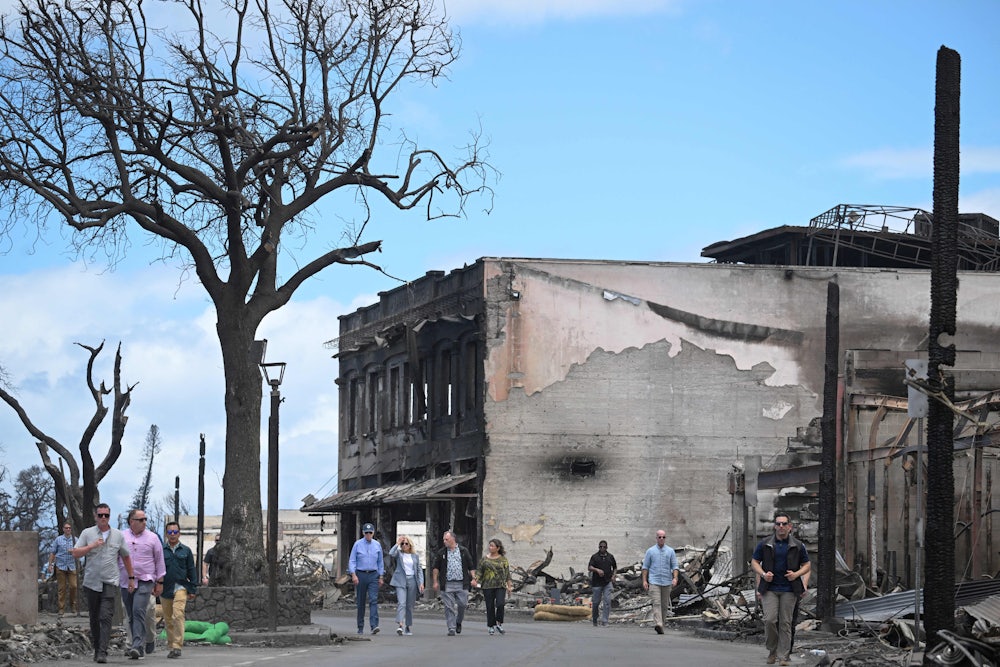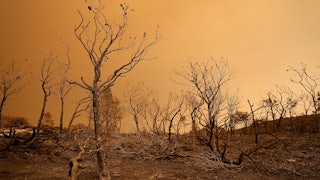The fire that devastated the Hawaiian island of Maui earlier this month was made all the worse by the deep-rooted effects of colonialism. As the recovery process begins, Native Hawaiians see an opportunity to correct the many wrongs caused by colonial capitalism. But the road to recovery is fraught with the same dangers that caused the fire in the first place.
At least 115 people died in the fire, and the number is expected to rise dramatically as search operations continue. At least 338 people are still unaccounted for. Much of the devastation was due to arid conditions, as well as resource mismanagement. Three of the main factors that helped the inferno spread were dry land, lack of water, and hot temperatures. All of these factors were supercharged by climate change; all are also linked to the hundreds of years of colonization that have shaped the islands’ recent history. Fire recovery could be a chance to right those wrongs—or risk further entrenching the same systems that led to the tragedy.
“We … have an opportunity where there’s an alignment of factors both micro and macro that gives us a window, if we can build enough power at the community level, to impact the recovery and rebuilding process, and we can rebuild something new that’s more reminiscent of our ancestors’ way of life,” said Kaniela Ing, the national director of the environmental group the Green New Deal Network. Ing is a seventh-generation Kānaka Maoli (Native Hawaiian) and also works as an Indigenous leader and activist.
“The energy is there. Even through all the grief and trauma, they’re already looking at solutions,” he told The New Republic.
Hawaii’s biggest source of income is tourism, which includes the service industry, transportation, and retail, according to the state’s Department of Business, Economic Development and Tourism. Agriculture makes up a tiny fraction of Hawaii’s gross domestic product, but farmland covers nearly 40 percent of the islands. As a result, crucial resources have been allocated to prioritize those two industries.
The United States first grew interested in Hawaii in the 1820s due to its potential for the sugarcane industry. Business investors eventually replaced traditional Hawaiian agriculture with a plantation economy, primarily growing sugarcane and pineapples.
The monocrop approach has leached nutrients out of the land. Neither of the major crops is native to Hawaii, so after a field stops being arable, invasive plants such as fountaingrass and Guinea grass are able to run wild. The non-native grasses dry out quickly and can fuel wildfires. In fact, some of the grasses have actually adapted to “thrive with fire,” according to the Pacific Fire Exchange, a Hawaiian fire science communication project.
Native plants such as āweoweo and naio, however, can actually help limit wildfires. The shrubs have higher water content and lower flammability than the invasive species, making them resistant to catching fire. But every time a wildfire occurs, more native plants and trees are killed. This leaves more room for the fast-growing invasive grasses to take over, creating a vicious cycle.
Hawaii has also been struggling in recent years with drought conditions, as well as decreasing rainfall, making Maui drier than it normally is. Kainoa Pestana, a field tech for the Pu’u Kukui Watershed Preserve on Maui, warned in 2022 that rainfall in the area had decreased significantly in the previous five years—going from more than 400 inches of rain at times to less than half of that.
But even as residents have been fined for using too much water amid state-imposed water shortages, plantations continue to water crops and hotels and resorts have full pools and lush, green grounds. The combination of poorly allocated water resources, dry conditions, and uncontrolled plant growth helped fuel the inferno until it became both the deadliest fire in Hawaii’s history and the deadliest U.S. wildfire in more than a century. The fires were also fanned by strong trade winds caused by a hurricane passing the state in early August; warmer than usual ocean and air temperatures can juice up hurricanes and make those winds stronger.
Meanwhile, colonialism has steadily decimated Hawaiian culture—and tourism has only kept up the process. Christian missionaries arrived in the islands in the 1820s and banned Hawaiians from speaking their native language, dancing the hula, and holding spiritual ceremonies. The missionaries’ children stayed and became business leaders or politicians, starting the massive displacement of Native Hawaiians.
More Native Hawaiians live on the mainland United States than on the islands for the first time in history, according to 2021 population estimates from the U.S. Census Bureau; sky-high housing prices in their homeland are a major factor. Resorts have been built over sacred areas of the islands, while many traditions, such as the lu’au, have been reduced to tourist attractions.
Native Hawaiians have been urging people for years to stop visiting the islands, because the high tourism rate is straining local resources too much. The calls grew more frequent during the peak of the coronavirus pandemic as residents worried outsiders would spread the virus. Now local residents are growing frustrated as they see resources already being diverted back to tourism instead of fire recovery. Some locals are taking to TikTok to urge potential tourists to stay away from the islands as they try to rebuild.
“There is a boat company that’s still taking out tourists snorkeling in the waters of Lahaina that still has bodies inside of the water,” Kailee Soong, a spiritual mentor who lives on Maui, said in a TikTok video captioned, “People are preying on trauma.”
“I just want to be clear: The resources here are limited because we live on an island,” Soong said. “This isn’t an argument about, ‘Oh, the tourism industry gives us financial gain.’ It is about the fact that they are in the way as people mourn the loss of their loved ones, of the places that burned down, of the history.”
One such place is Lahaina, the original capital of the Hawaiian kingdom. Its destruction marks a major loss of deep cultural history.
Many people who were displaced due to the fire have been living in hotels or Airbnbs. But some hotels are hoping to reopen in less than two weeks, NPR reported, meaning that Maui residents could be left homeless.
If they lose that housing assistance, there is real danger that Native Hawaiians will be displaced even faster than they already are. Real estate developers are already making offers to buy scorched property from Maui residents. If they succeed, it will become even harder to find affordable housing in the islands. Hawaii has a high percentage of families that live in multigenerational homes. If they are forced to move to the mainland, it would mark a massive loss of Indigenous knowledge and Hawaiian culture.
Hawaii Governor Josh Green promised last week to work toward imposing a moratorium on land transactions in Lahaina to protect residents from predatory buyers. So far, it has yet to materialize.
In Maui, residents are starting to mobilize. One Lahaina resident, Richy Palalay, told the Star-Advertiser, “I don’t have any money to help rebuild. I’ll put on a construction hat and help get this ship going. I’m not going to leave this place.”
Ing said many locals have proposed raising money to buy back land and put it in a land trust for themselves, or using funds from the Department of Hawaiian Home Lands to buy property in Lahaina, to make sure it stays affordable. Community leaders are also working with the Federal Emergency Management Agency to teach residents how to navigate the federal aid process and have conversations with authorities about getting supplies.
Ing believes that there needs to be a massive economic overhaul, so that policies are better set up to respond to human needs and the climate crisis. “This is a wake-up call for not just those who hold power over the redevelopment of Maui, but globally, ” he said.
He saw an odd symbolism in how Native Hawaiians can rebuild after the wildfire. Hawaii’s creation myth says that two gods had a stillborn baby, who was buried and grew into a kalo, or taro, plant. The gods’ second baby was the first human, who was fed kalo.
“We are a people birthed out of the flame,” Ing said. “The first kalo comes out of the lava flow. And that’s like our ancestors.”








